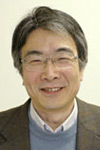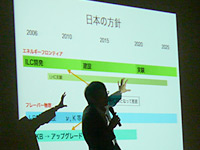Director's Corner
22 November 2006
 Mitsuaki Nozaki |
The Japanese Strategy of High-Energy Physics: Full Support for the ILC
Today's issue features a Director's Corner from Mitsuaki Nozaki, GDE Asian Regional Director.
A community-wide consensus is inevitable to promote a big project like the International Linear Collider, otherwise the project will not be supported by other science disciplines and governments. The US and European communities have set out their strategies for particle physics and presented their plans and prioritised their projects.
The Japanese community has also discussed its future plan. In 2008, the integrated luminosity of the KEK B factory is expected to reach its present goal of 1 ab-1 and the construction of J-PARC, the next major accelerator in Japan, will be completed. Under these circumstances, it is urgent for us to make the next plan for the upcoming decade.
 Japan discusses the future of particle physics. |
After a long discussion, we reached a conclusion in which the ILC was given the highest priority, considering the importance of the TeV-scale physics. Although the significance of the LHC is unquestionable, the Japanese contribution to the LHC project, both in accelerator and detector development, is modest. We recommended that the community-wide effort be focused on the ILC at the energy frontier.
In order to strengthen the activities to build the ILC, it is encouraged that more researchers should participate in this international project. One example is to utilise the KEK B factory as a R&D machine for the ILC damping ring.
Our strategy does not mean that all the projects apart from the ILC will be terminated. The Japanese community also recommended that flavour physics in both lepton and quark sectors should be pursued by using luminosity or intensity-frontier accelerators. The community expects flavour physics to explore the physics at very high energies that even the energy frontier accelerators cannot reach.
Considering the long lead-time for building the ILC, the physics output before the start of the project's experiments makes it important for the high energy physics community to maintain its vital activities in this field. It is also essential to keep attracting young scientists who will eventually do the physics at the ILC. By 2010, there will be only a few high-energy accelerators in operation in the whole world. We can expect a continuous physics outcome at both KEKB and J-PARC.
Although our scenario needs an increase in the total annual budget for high-energy physics, if our strategy is accepted by the government and the proposed projects are properly funded, we can push ILC R&D forward together with the on-going projects that will provide a variety of physics opportunity to the world HEP community in the next decade.
The Japanese Strategy of High-Energy Physics (PDF in Japanese)
-- Mitsuaki Nozaki